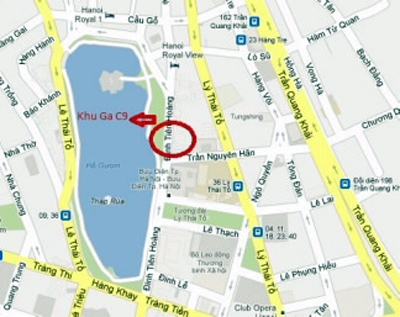Hoan Kiem station fires up debate

In the recent past the Hanoi People’s Committee gave the thumbs-up to placing the train station C9, part of urban rail route No 2, in front of Hanoi Power Corporation in Dinh Tien Hoang road, just a short distance from Ho Guom in the Hoan Kiem District, often considered the heart of Vietnam’s capital.
The station will go mostly underground with only about three metre high roof being visible.
Reacting to the plan, a protest group argued that putting a train station near Ho Guom could increase traffic pressures in this already crowded area and might damage the landscape and historic architectural character of the lake and the neighborhood.
“Ho Guom is a traditional, festive and spiritual space which has existed for years. Some people even said ‘One had yet to visit Hanoi if he/she did not go to Ho Guom’. So what must we do to honour this special place,” said Dao Ngoc Nghiem,deputy chairman of Hanoi Urban Planning and Development Association.
Nghiem said the areas near Ho Guom were planned as routes for pedestrians. Hence, if a train station was put there, it might discomfort passengers and hinder linkages to other city areas.
Vietnam Federation of Civil Engineering Association deputy chairman Dr. Pham Si Liem said that since the train station was designed to link to other underground facilities like parking sites or underground marts, it could attract throngs of people, whereas current Ho Guom area was crowded with diverse buildings, leading to lack of space for other transport vehicles to approach.
Liem suggested moving the train station to more spacious areas like the city’s Opera House square.
Nguyen Van Hung , former rector and associate professor at the University of Civil Engineering, also said that placing the C9 station near Ho Guom relic complex might obstruct the traffic. He suggested removing the station to Nguyen Huu Huan road which connects to Ho Guom through two small roads.
From the opposite site, some experts and state authorities defended their decision..
Chairman of Vietnam Association of Architects Nguyen Tan Van said the proposed position of C9 station did no harm to Ho Guom’s landscape. Van argued most of the station running underground with only a visible roof would not affect old quarters’ general view.
“One of major principles in building a subway itinerary is targeting vibrant commercial and cultural areas with the potential for huge passenger volumes and Ho Guom is one of such places,” said Dr. Nguyen Xuan Thuy, former director of the Transport Publishing House.
A representative from Hanoi People’s Committee confirmed the selected position was the best option to place C9 station as it had undergone thorough studies by the Japan design consultancy unit and relevant Vietnamese agencies.
According to Dao Minh Tam, deputy head of Hanoi Planning and Architecture Department’s Technical Infrastructure Planning Division, the position of C9 station was approved by the Ministry of Culture, Sports and Tourism and Hanoi People’s Committee as it would bring passengers comfort when approaching cultural, historical, social and economic venues in central Hanoi.
Hanoi’s urban rail route No 2 spans 11.5km long, including 8.5km section going underground via the city’s ancient quarters, the Returned Sword Lake and surrounding areas. Its total investment capital is around VND20 trillion ($960 million) sourcing Japanese government ODA capital and Vietnamese reciprocal capital.
The system consists of 10 stations, including seven underground and three aerial ones.
What the stars mean:
★ Poor ★ ★ Promising ★★★ Good ★★★★ Very good ★★★★★ Exceptional
 Tag:
Tag:
Related Contents
Latest News
More News
- Global partnerships key to Vietnam’s IFC development (December 26, 2025 | 16:18)
- Vingroup pulls out of bid to invest in North-South high-speed railway (December 26, 2025 | 11:42)
- Strengthening supply chains through trade promotions and customs reform (December 24, 2025 | 14:00)
- PM orders investment model for North–South high-speed rail (December 22, 2025 | 17:43)
- LS Eco Energy to invest in Vietnam rare earth sector (December 22, 2025 | 17:31)
- Government moves to establish International Financial Centre (December 21, 2025 | 21:00)
- Vietnam's IFC to target global investment flows (December 21, 2025 | 18:00)
- Two national hospitals expand capacity with new facilities (December 20, 2025 | 09:00)
- Ha Tinh breaks ground on major Vingroup industrial and energy projects (December 19, 2025 | 18:24)
- EVN launches major power infrastructure projects nationwide (December 19, 2025 | 18:17)























 Mobile Version
Mobile Version